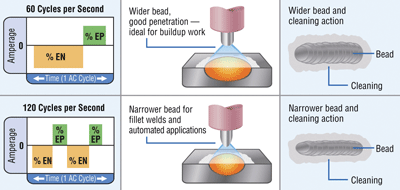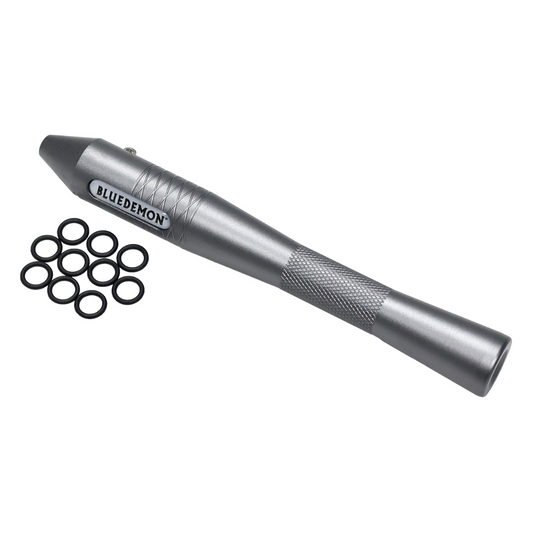Today’s guest post is by Mark Kadlec of Miller Electric:
Before the introduction of inverter-based gas tungsten arc welding (GTAW)
machines, frequency control was rarely thought of as a way to improve aluminum
welding. The current that came from the wall—60 hertz—was the same current that went into the weld. Since then, countless operators have sworn off this
mentality after seeing firsthand the benefits of adjustable output frequency.
A major revolution in frequency technology came with the invention of the
inverter. Conventional technology limits AC frequency to 50 or 60 HZ, the same
as single-phase input power. Inverter technology, however, allows output
frequencies between 20-400 Hz.
The inverter also allowed for the development of the advanced square wave,
which decreases the time it takes for the current to reverse directions,
increasing arc stability even more and eliminating the need for continuous high
frequency. Compared to conventional machines, inverters let you add about 25%
more heat into the work in the same amount of time. This increases penetration
per amp of welding power.
Frequency Defined
Frequency, or Hz, is the number of times the AC TIG arc switches between
electrode positive (EP) and electrode negative (EN) in one second. In the United
States the frequency of its delivery is 60 cycles per second (60 Hz). This means
there are 120 reversals of current flow direction through the arc per second.
Increasing the frequency above 60 Hz increases the arc stability and
provides a narrow arc with greater directional control. Lowering the frequency
to 60 Hz or less reduces arc stability and produces a soft and wide arc.
Controlling the Arc Cone
An AC TIG inverter is ideal for welding aluminum because it allows you to
fine-tune the weld bead profile by controlling arc cone shape and arc force
through increased balance and frequency control. It helps to think of an
inverter as if you’re adding a nozzle to a fire hose. It lets you change the
shape and force of the “water” (welding current) from a wide fan to a more
focused stream. An arc cone at 400 Hz is much tighter and more focused at the
exact spot the electrode is pointing than an arc cone operating at 60 Hz.
Unlike other types of waveform control, such as balance and amplitude,
frequency control provides good penetration at both low and high frequencies.
The primary difference between the two is the width of the arc cone and
resulting weld bead. Balance control affects cleaning action, tungsten life and
penetration.
Adjustable Frequency Advantages
Here are some of the advantages of having an adjustable frequency:
- Higher frequency yields a narrower arc
- Higher frequency produces a more stable and directional arc
- Lower frequency widens arc
- Lower frequency produces a softer less forceful arc
Increasing the Frequency
Increasing AC frequency (“constricting the nozzle”) provides a more focused
arc cone with increased directional control and a narrower weld bead and
cleaning area. Increased frequency helps when welding in corners, on root
passes, fillet welds, lap and T-joints.
On lap and T-joints, using a higher frequency lets you establish the weld
puddle exactly at the root. This can ensure good penetration, control bead width
and minimize the etched zone. The operator can direct the arc precisely at the
joint and not have the arc dance from plate to plate. Increasing frequency also
may increase travel speed up to 40 percent in certain applications.
Decreasing the Frequency
Decreasing frequency produces a broader arc cone, which widens the weld bead
profile and better removes impurities from the surface of the metal. It also
transfers the maximum amount of energy to the workpiece, which speeds up
applications requiring heavy metal deposition. Frequencies below 60 Hz transfer
more energy into the work and create a wider bead with decent penetration – an
ideal combination for build-up work, to catch both edges of an outside corner or
making a fill pass while maintaining travel speed.

AC Frequency control controls the width of the arc
cone. Increasing the AC frequency provides a more focused arc with increased directional control. Decreasing the AC frequency softens the arc and broadens the weld puddle for a wider weld band.
Overall, a good starting point for general welding is 80 to 120 hertz. These
frequencies are comfortable to work with, increase control of the arc direction,
and boost travel speed. To achieve full penetration in the weld without putting
too much amperage in the metal, frequency should be increased to 200 Hz for a
fillet weld application. For buildup work, frequency should start at 60 Hz and
be adjusted lower from there.
Mark Kadlec
Welding Technician, Tig Solutions
Miller Electric Mfg. Co. An
ITW Company
Mark Kadlec has been in the welding industry for the past 40 years.
Since 1998, his focus has been product development and applications as a Welding
Technician/Engineer for Miller’s TIG Solutions. Prior to this role, Mark held
manufacturing and Third Party Certification roles within Miller.




